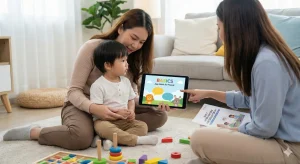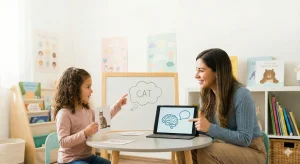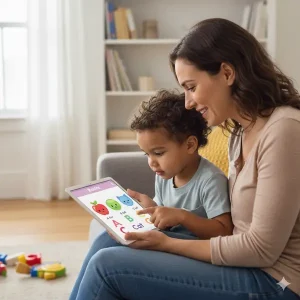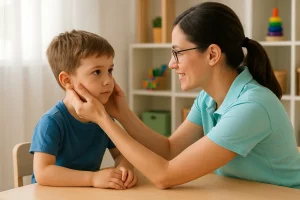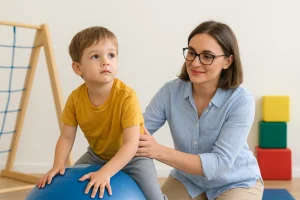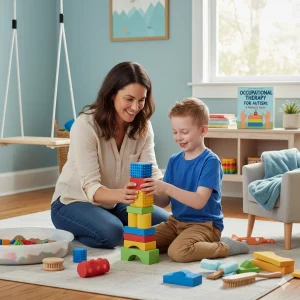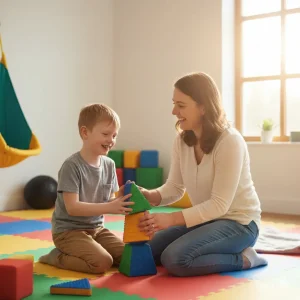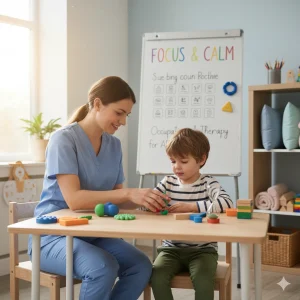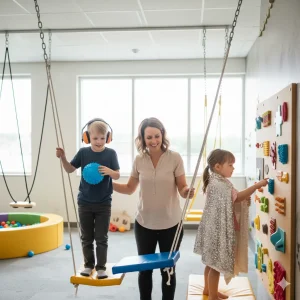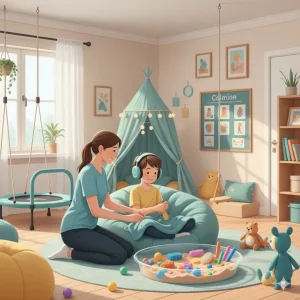Occupational Therapy 2 Year Old Milestones: A Complete Parent’s Guide
By Wellness Hub
Last Updated: October 11, 2025
Your child’s second birthday isn’t just a celebration — it’s a big leap in development. At age two, toddlers begin exploring the world with curious hands, steady steps, and their first real sense of independence. This is why understanding occupational therapy 2 year old milestones is so important for parents.
Occupational therapy helps nurture the fine motor skills needed for holding crayons and feeding themselves, the gross motor milestones that support climbing, running, and balance, and the sensory processing skills that help toddlers feel safe and confident in their environment. It also encourages early self-care abilities like using a spoon or washing hands.
Why Occupational Therapy Matters at Age 2
Turning two is a big step in your child’s development. At this stage, children are learning to move more confidently, use their hands with better control, and explore the world through all their senses. This is exactly where pediatric OT for toddlers plays a vital role. Occupational therapists don’t just look at one skill in isolation — they carefully track 2-year-old developmental milestones across multiple areas like movement, play, self-care, and sensory processing.
A therapist will often use a developmental checklist age 2 to understand how your child is progressing. This includes checking how well your toddler can grasp small objects, climb stairs, imitate simple actions, or communicate with gestures and early words. These everyday moments give important clues about your child’s overall development.
Early screening is especially important because it helps spot challenges before they grow bigger. For example, some children may show toddler sensory issues — they might be extra sensitive to textures, sounds, or movement. These early signs don’t always mean something is wrong, but identifying them early allows therapists to provide the right support when it matters most.
Early intervention for toddlers can make a lasting impact. By guiding families with simple play-based strategies, OTs help children build the skills they need to become more confident and independent. At this age, small changes can shape big outcomes — and that’s why occupational therapy at age two is so powerful.
2-Year-Old Developmental Milestones Occupational Therapists Look For
At age two, your child’s world starts to grow bigger — not just physically, but through every new skill they learn. Occupational therapists closely observe how toddlers move, play, and interact with their environment to understand their overall development. These 2-year-old developmental milestones help identify strengths, spot early concerns, and guide parents in supporting their child’s growth at home.
Below are some key areas OTs focus on during assessments and early intervention sessions.
Fine Motor Milestones at 2 Years
Fine motor skills are all about how your toddler uses their hands, fingers, and eyes together. At this stage, children begin to show more control and purpose in their movements. Common fine motor milestones at 2 years include stacking four or more blocks, holding a crayon with their fingers instead of a fist, and making simple scribbles.
These early skills build the foundation for future handwriting, dressing, and self-care activities. Occupational therapists often use play — like puzzles, building blocks, and drawing — to strengthen toddler fine motor skills and visual-motor integration (the ability to coordinate what the eyes see with what the hands do).
Simple home activities like coloring, stacking cups, or playing with clay can give your toddler a big developmental boost.
Gross Motor Milestones at 2 Years
By age two, most toddlers love to move — a lot! They’re learning to run, climb, kick a ball, and walk up and down stairs with growing confidence. These are key gross motor milestones at 2 years, showing progress in balance, strength, and body coordination.
Occupational therapists pay close attention to bilateral coordination (how both sides of the body work together), which is essential for skills like jumping or catching a ball. Early motor development in these areas also helps with confidence, body awareness, and safe movement during everyday play.
Encouraging your toddler to play outdoors, climb on safe structures, or push and pull toys can naturally support these skills at home.
Sensory Processing and Regulation
At age two, children are constantly taking in new sensations — from touch and sound to movement and balance. Healthy sensory processing in toddlers allows them to feel safe, explore confidently, and focus on learning.
Occupational therapists often look for sensory red flags in 2-year-olds, like avoiding certain textures, covering their ears often, or getting overwhelmed in noisy environments. These signs don’t always mean something serious, but they can signal a need for extra support.
Through gentle play-based strategies, OTs help children learn how to regulate their sensory systems — whether that’s through swinging, jumping, or deep pressure play — to build calmness and focus.
Self-Care (ADL) Skills
One of the most exciting parts of turning two is watching your child do more things on their own. These self-care skills for 2-year-olds, also called ADL (Activities of Daily Living), include using a spoon or open cup, pulling off socks or simple clothing, and beginning early dressing routines.
Occupational therapy supports feeding skills like scooping with a spoon or drinking without spills, as well as independence in daily tasks. Occupational therapy for toddlers is not just about motor skills — it’s about building confidence and preparing your child for everyday routines like eating, washing hands, or getting dressed.
Simple daily practice with patient guidance can help your toddler build these important life skills step by step.
Bottom line: Each of these milestones gives a window into your child’s growth. When children are supported early — through playful routines, sensory experiences, and skilled OT guidance — they build the strong foundation they need for preschool and beyond.
Speech, Play, and Social Milestones Linked to OT
Your child’s second year isn’t just about movement and motor skills — it’s also when communication and connection begin to blossom. At this age, toddlers are learning to express themselves, play alongside others, and build the foundations for future social skills. These are just as important as physical development, and occupational therapists carefully observe them during assessments and early intervention sessions.
Language Development: Two-Word Phrases
By age two, most children start to combine words to express simple thoughts. This two-word phrases milestone might look like “more milk,” “mama go,” or “throw ball.” These small but powerful word combinations help your toddler share their needs, interact with family members, and understand cause-and-effect in daily routines.
OTs often collaborate with speech-language pathologists or integrate language-building strategies into therapy sessions. For example, they may encourage communication during play or daily routines, helping children build vocabulary through repetition, modeling, and gestures. For parents, responding warmly to your child’s early words and expanding on what they say can make a big difference in supporting their communication growth.
Play Skills: Parallel Play and Imitation
Play is how toddlers learn best. Around two years old, children often engage in parallel play at 2 years, where they play beside other children rather than directly with them. This may seem simple, but it’s an important stage in learning how to share space, observe peers, and build early social awareness.
OTs also look at imitation skills — copying actions like clapping, stacking blocks, or pretend feeding a doll. These are stepping stones to cooperative play and stronger communication later on. Encouraging your toddler to mimic simple gestures or participate in daily routines like tidying up toys helps nurture these early play milestones.
Social Interaction Skills OTs Observe
Social milestones at age two are about connection, trust, and shared moments. Typical social milestones at 2 years include showing affection to familiar people, responding to their name, pointing to show interest, and seeking comfort from caregivers. These early skills lay the foundation for friendships, empathy, and emotional understanding in preschool years and beyond.
Occupational therapists pay close attention to how toddlers respond to others, whether they seek help, share joy, or engage in simple social routines like waving bye-bye. If a child seems withdrawn or struggles with these interactions, early guidance can make a meaningful difference.
Through playful, natural interactions, OTs help children build confidence, connect with others, and develop essential communication and social skills. Parents can support this at home by modeling emotions, narrating daily routines, and giving their child plenty of opportunities to play and interact with both adults and peers.
In short: Language, play, and social interaction are powerful tools for your toddler’s development. Recognizing these milestones — from two-word phrases to parallel play — can help parents nurture strong communication and social skills early on, setting their child up for a lifetime of learning and connection.
Red Flags and When to Seek an OT Evaluation
Every child develops at their own pace — and that’s perfectly okay. But sometimes, small signs can indicate that a child may need extra support to reach their full potential. Recognizing these early red flags can help parents take action at the right time. Occupational therapists (OTs) play a key role in identifying delays and guiding families toward the right interventions.
Signs Your 2-Year-Old Might Need Occupational Therapy
Some children may show early signs that point to challenges in fine motor, sensory, or play skills. If you notice your child struggling with everyday activities or avoiding certain sensations, it may be time to consider when to see an occupational therapist for a 2-year-old.
Here are a few toddler sensory red flags and developmental concerns to watch for:
- Difficulty stacking blocks, scribbling, or grasping small objects (poor fine motor control)
- Avoiding certain textures, sounds, or movement experiences (sensory avoidance)
- Limited interest in play, difficulty imitating, or trouble staying engaged in activities
- Frequent meltdowns in busy or noisy environments
- Avoiding eye contact or struggling to interact with peers
Not every child who shows one or two of these signs needs therapy — but noticing patterns over time can help guide your next steps. The earlier you address these concerns, the more support your child receives during critical developmental windows.
Developmental Screening and Early Intervention
If you’re unsure about your child’s development, a developmental screening is a great first step. Many pediatricians and therapists use standardized tools like the M-CHAT (Modified Checklist for Autism in Toddlers) and developmental checklists to look at overall growth in motor, language, sensory, and social areas. These screenings help determine whether your child might benefit from an OT evaluation for toddlers.
When challenges are identified early, early intervention can make a powerful difference. OTs create personalized, play-based plans to build skills in a way that feels natural and fun for children. Whether it’s improving sensory regulation, strengthening fine motor skills, or supporting social interaction, early therapy can help children feel more confident and capable.
If you have even a small concern, don’t wait. A simple evaluation can provide reassurance, guidance, or early support — all of which can positively shape your child’s developmental journey.
Bottom line: You know your child best. Trust your instincts, keep an eye on these toddler sensory red flags, and don’t hesitate to seek an OT evaluation if something feels off. Early action can help your child build the skills they need to thrive.
Activities to Support 2-Year-Old Milestones at Home
The best way for toddlers to learn is through play. At age two, every little activity — stacking blocks, running outside, or feeding themselves — is helping to build essential developmental skills. Parents play a powerful role in this stage by creating simple, everyday opportunities for their child to practice new abilities.
Occupational therapists often recommend playful, hands-on experiences to strengthen fine motor skills, support sensory regulation, and encourage independence. Here are a few practical at-home activities to support your child’s 2-year-old milestones.
Fine Motor & Bilateral Coordination
Toddlers are naturally curious, and their hands are their biggest tools for exploring the world. Simple fine motor activities for toddlers like stacking blocks, scribbling with crayons, or threading large beads help build hand strength, control, and bilateral coordination — the ability to use both sides of the body together.
You can support this at home by:
- Offering stacking toys or cups to encourage precise hand movements
- Giving chunky crayons or markers for easy scribbling and early pre-writing skills
- Providing lacing cards or large beads for threading to build coordination and focus
These bilateral coordination activities for 2-year-olds not only support fine motor milestones but also help prepare your child for future skills like dressing, feeding, and writing.
Gross Motor & Sensory Play
Two-year-olds love to move — and movement is essential for developing balance, strength, and body awareness. Gross motor play helps build confidence and coordination, while sensory experiences help children learn how their bodies interact with the world around them.
Try these simple OT-approved sensory activities for 2-year-olds:
- Playing at the playground — climbing, sliding, and running
- Using push-pull toys to improve balance and coordination
- Creating simple obstacle courses indoors with pillows or cushions
- Dancing or jumping to music to build rhythm and motor planning
Sensory-rich play strengthens the vestibular and proprioceptive systems, helping toddlers feel more grounded and regulated throughout their day.
Also read: Is Your 1-Year-Old Delayed? Occupational Therapy for 1-Year-Old
Self-Care and Independence
This is also the perfect age to start building independence through everyday routines. Self-care routines for toddlers—like feeding themselves, washing hands, or trying to dress—boost not only motor skills but also confidence.
Here are some practical ways to build ADL skills at 2 years:
- Encourage your child to use a spoon or open cup at meals
- Turn handwashing into a fun game with bubbles and songs
- Offer easy-to-remove clothing like elastic pants or Velcro shoes for dressing practice
These small steps teach toddlers to take care of themselves in age-appropriate ways, making everyday routines smoother for both parents and children.
In short: The most powerful learning at this age happens during play. By adding simple fine motor tasks, gross motor adventures, and everyday self-care routines to your child’s day, you can support their growth naturally — just like occupational therapists do in therapy sessions. Consistent practice, patience, and playful encouragement can make a big difference in your child’s developmental journey.
How Occupational Therapists Help Your Toddler Thrive
For many parents, the word “therapy” can feel overwhelming at first — but occupational therapy for toddlers is actually playful, nurturing, and family-centered. The goal isn’t to make your child “catch up” overnight but to help them build skills in a way that feels natural and joyful. A pediatric OT focuses on helping young children grow stronger in the areas they need most: fine and gross motor skills, sensory regulation, play, communication, and everyday self-care.
At this age, therapy isn’t about worksheets or rigid drills. It’s about creating meaningful experiences through movement, play, and connection. Here’s how occupational therapists support your toddler’s development:
Play-Based Therapy: Learning Through Fun
One of the most effective ways toddlers learn is through play-based therapy. OTs use playful activities that look and feel like everyday games but are carefully designed to build important developmental skills.
Examples might include:
- Stacking and sorting games to strengthen fine motor skills
- Obstacle courses that boost balance, coordination, and confidence
- Pretend play to build social, communication, and problem-solving skills
- Sensory-rich activities like swinging, bouncing, or finger painting to support emotional regulation
Because toddlers are naturally curious, these play experiences help them learn faster — without feeling like “therapy.”
Sensory Integration: Supporting Calm and Focus
Many toddlers experience big emotions and strong reactions to the world around them. Some may avoid certain textures, get overwhelmed in noisy places, or seem “on the go” all the time. Through sensory integration strategies, pediatric OT helps children learn how to regulate their sensory systems so they can participate more comfortably in daily activities.
This might include activities that stimulate or calm the sensory system, like deep pressure play, swinging, or pushing heavy objects. Over time, these activities help children feel safer in their bodies, improving attention, behavior, and participation.
Parent Coaching: Empowering Families at Home
An essential part of occupational therapy is parent coaching. OTs don’t just work with children — they guide families on how to support growth outside the therapy room. Parents learn simple, everyday strategies to build skills at home through play, routines, and gentle encouragement.
This collaborative approach ensures therapy doesn’t stop at the clinic — it becomes part of daily life. From encouraging self-feeding to creating calming sensory routines, parent involvement is what helps toddlers make real, lasting progress.
In short: Occupational therapy is about more than building skills — it’s about helping children thrive. With pediatric OT, play-based therapy, and supportive parent coaching, families get the tools they need to help their toddlers grow stronger, more confident, and more independent every day.
Conclusion
Your child’s second year is full of exciting growth — walking, talking, and exploring the world. Understanding occupational therapy 2 year old milestones helps you support this journey with confidence. Early screening can spot small challenges before they become bigger. If your toddler is delayed or shows sensory issues, a pediatric OT can guide you with simple, playful strategies. Everyday activities like stacking, scribbling, and running build strong skills. Don’t wait to act — early help makes a big difference.
Frequently Asked Questions
1. What are the key occupational therapy 2 year old milestones?
At age two, toddlers begin to show rapid growth in many areas. Key milestones include fine motor skills like stacking blocks and scribbling, gross motor skills like running, climbing, and kicking, and language milestones like using simple two-word phrases. Occupational therapists also look at sensory responses and early self-care abilities such as feeding or washing hands. These skills lay the foundation for independence and learning.
2. When should I see an occupational therapist for my 2-year-old?
If your toddler seems delayed in movement, play, speech, or sensory processing, it may be time to seek an OT evaluation. Some signs include avoiding textures, difficulty stacking or drawing, poor coordination, or delayed communication. When to see an occupational therapist for a 2-year-old depends on your child’s unique needs — but early help can make a big difference.
3. What fine motor skills should a 2-year-old have?
By this age, toddlers typically can stack 4 or more blocks, hold a crayon with their fingers, and make simple scribbles. They also start using both hands together — a skill called bilateral coordination. These fine motor milestones at 2 years help prepare them for future skills like dressing, feeding, and writing.
4. How do sensory issues show up in toddlers?
Toddler sensory red flags can include avoiding certain textures like sand or grass, covering their ears with loud sounds, or seeking constant spinning, jumping, or movement. Some children may overreact to touch or noise, while others may seem unaware. A pediatric OT can help your child learn to process and respond to sensory input more comfortably.
5. What is parallel play at 2 years?
Parallel play at 2 years means toddlers play beside each other without directly interacting. It may look like two kids building blocks next to each other but not sharing. This is a normal and healthy step in social development. It helps children learn social awareness, turn-taking, and how to play cooperatively as they grow older.
6. How can I help my 2-year-old meet developmental milestones at home?
Parents can make a big impact through simple daily routines. Fine motor activities for toddlers like stacking blocks, scribbling, or threading beads build hand skills. Gross motor play like climbing, running, or using push-pull toys strengthens balance and coordination. Encouraging self-feeding and handwashing builds independence. Play is learning at this age.
7. Does my 2-year-old need occupational therapy if they’re not talking much?
Not every child develops language at the same speed. But if your toddler isn’t using two-word phrases like “more milk” or “go park,” or seems frustrated while communicating, it may be worth checking with a pediatric OT or speech therapist. Early support can help your child express themselves and build stronger social skills.
8. What happens during an OT evaluation for toddlers?
During an OT evaluation for toddlers, the therapist observes how your child moves, plays, communicates, and responds to different sensations. They may use simple checklists, toys, and games to assess fine motor skills, gross motor development, sensory responses, and self-care abilities. This helps create a clear, personalized plan to support your child’s growth.
9. Can occupational therapy help with feeding and dressing?
Yes! A big part of OT is helping toddlers develop self-care skills. This includes using a spoon or fork, drinking from an open cup, washing hands, and putting on or taking off simple clothing. OTs use playful and supportive strategies to help children build confidence in daily routines, making them more independent over time.
10. Why is early intervention important for 2-year-olds?
Early intervention gives children the best chance to learn during their most sensitive developmental years. Getting help early can make delays easier to address, build strong foundations for learning, and boost your child’s confidence. With the right support, toddlers can thrive and meet their milestones more smoothly
About Author:
Sonali Sharma, Occupational Therapist
Sonali Sharma is a skilled Occupational Therapist at Wellness Hub, with over three years of experience in supporting children with developmental, behavioral, and learning challenges. She holds a Bachelor’s in Occupational Therapy (BOT) from Amity University and has worked with leading institutions such as NIMHANS Bengaluru and ESIC Hospital Faridabad.
At Wellness Hub, Sonali provides online occupational therapy sessions tailored to each child’s needs. She specializes in pediatric therapy, autism support, sensory integration, and developmental skill-building, helping children strengthen motor skills, improve focus, and become more independent in daily life.
Her therapy style is child-centered, play-based, and evidence-driven—making sessions both effective and enjoyable for kids. Sonali also equips parents with practical home therapy strategies to extend progress beyond sessions.
Passionate about empowering families, Sonali believes in creating a nurturing space where children can thrive while parents feel supported every step of the way.
Book your Free Consultation Today
Parent/Caregiver Info:
Client’s Details:
* Error Message
